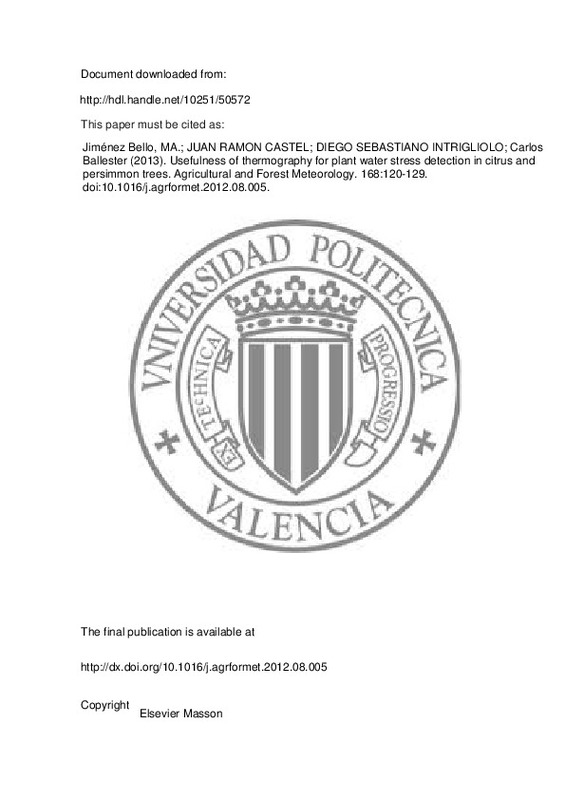Ballester, C.; Jiménez Bello, MÁ.; Castel, JR.; Intrigliolo, DS. (2013). Usefulness of thermography for plant water stress detection in citrus and persimmon trees. Agricultural and Forest Meteorology. 168:120-129. https://doi.org/10.1016/j.agrformet.2012.08.005
Por favor, use este identificador para citar o enlazar este ítem: http://hdl.handle.net/10251/50572
|
Título:
|
Usefulness of thermography for plant water stress detection in citrus and persimmon trees
|
|
Autor:
|
Ballester, Carlos

 Jiménez Bello, Miguel Ángel
CASTEL, JUAN RAMON
INTRIGLIOLO, DIEGO SEBASTIANO
Jiménez Bello, Miguel Ángel
CASTEL, JUAN RAMON
INTRIGLIOLO, DIEGO SEBASTIANO
|
|
Entidad UPV:
|
Universitat Politècnica de València. Instituto Universitario de Ingeniería del Agua y del Medio Ambiente - Institut Universitari d'Enginyeria de l'Aigua i Medi Ambient
|
|
Fecha difusión:
|
|
|
Resumen:
|
[EN] The feasibility of using canopy temperature (Tc) measured with a hand-operated infrared thermographic camera as a water stress indicator was evaluated in the field during two seasons on citrus and persimmon trees ...[+]
[EN] The feasibility of using canopy temperature (Tc) measured with a hand-operated infrared thermographic camera as a water stress indicator was evaluated in the field during two seasons on citrus and persimmon trees subjected to different levels of deficit irrigation. In both species, which differ in leaf anatomy and stomatal response to environmental conditions, Tc was compared with midday stem water potential (s) measurements. In persimmon trees, leaf stomatal conductance (gs) was also measured. In 2009, images were taken from the sunlit and shady sides of the canopies. Based on the results obtained, during the second experimental season images were taken from the sunlit side of the trees and also from above the canopy. In persimmon, trees under deficit irrigation had lower s and gs what resulted in a clear increase in Tc regardless of the position from where the pictures were taken. The maximum Tc difference between deficit-irrigated and control trees observed was of 4.4 ◦C, which occurred when the stressed trees hads values 1.1 MPa lower than the control ones. In persimmon trees, Tc was the most sensitive indicator of plant water status particularly due to the lower tree-to-tree variability as compared to s and gs. On the other hand, in citrus trees Tc was not always affected by plant water stress. Only in the second experimental season, when air vapour pressure deficit values were below 2.7 kPa and images were also taken from above the canopies, deficit-irrigated trees had higher Tc than the control ones, this difference being at most 1.7 ◦C. Overall, the results show that hand-operated thermographic cameras can be used to detect plant water stress in both fruit tree species. Nevertheless, the use of Tc measurements to detect plant water stress appears to be more precise in persimmon than in orange citrus. This might be because persimmon trees have larger leaf size which determines higher canopy resistance allowing for higher increases in canopy temperature in response to water stress via stomatal closure. © 2012 Elsevier B.V. All rights reserved.
[-]
|
|
Palabras clave:
|
Canopy temperature
,
CWSI
,
Intra-crown temperature variability
,
Regulated deficit irrigation
,
Stem water potential
,
Stomatal conductance
|
|
Derechos de uso:
|
Reserva de todos los derechos
|
|
Fuente:
|
Agricultural and Forest Meteorology. (issn:
0168-1923
)
|
|
DOI:
|
10.1016/j.agrformet.2012.08.005
|
|
Editorial:
|
Elsevier Masson
|
|
Versión del editor:
|
http://dx.doi.org/10.1016/j.agrformet.2012.08.005
|
|
Código del Proyecto:
|
info:eu-repo/grantAgreement/MEC//CSD2006-00067/ES/Programa integral de ahorro y mejora en la productividad del agua de riego en la horticultura española/
|
|
Agradecimientos:
|
The authors thank E. Badal, I. Buesa, J. Castel, D. Guerra, D. Perez, F. Sanz and A. Yeves, for their help in field work. This research was supported by funds from projects RIDECO-CONSOLIDER CSD2006-00067, Telerieg Interreg ...[+]
The authors thank E. Badal, I. Buesa, J. Castel, D. Guerra, D. Perez, F. Sanz and A. Yeves, for their help in field work. This research was supported by funds from projects RIDECO-CONSOLIDER CSD2006-00067, Telerieg Interreg IV Sudoe and "Proyecto Integral Caqui". D.S. Intrigliolo acknowledges the financial support received from the Spanish Ministry of Economy and Competitiveness (MINECO) program "Ramon y Cajal".
[-]
|
|
Tipo:
|
Artículo
|







![[Cerrado]](/themes/UPV/images/candado.png)


